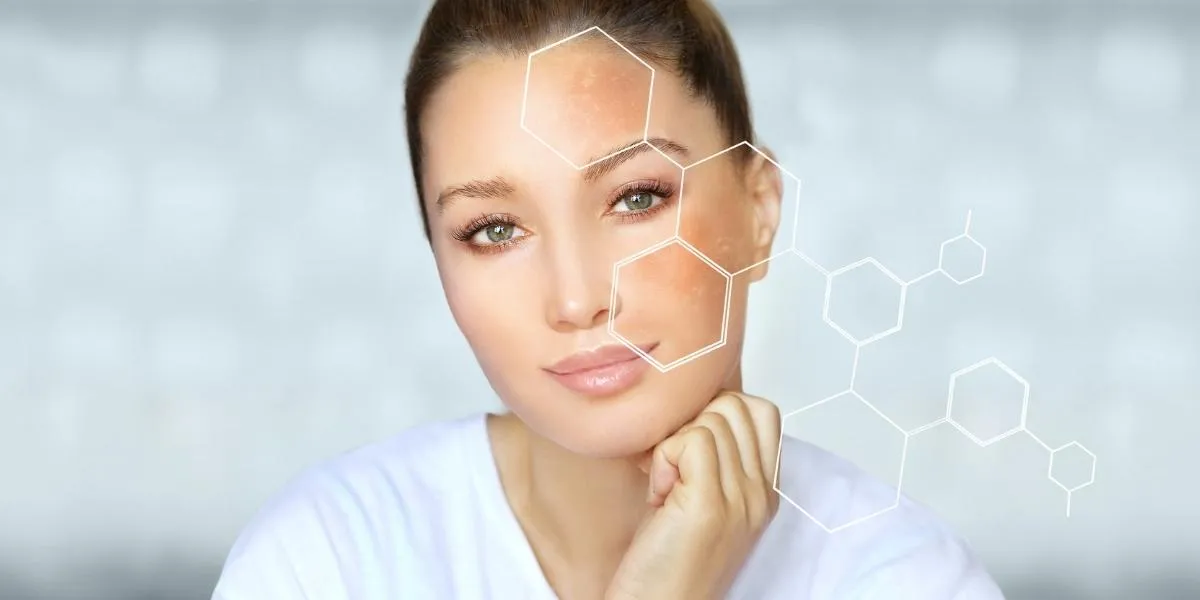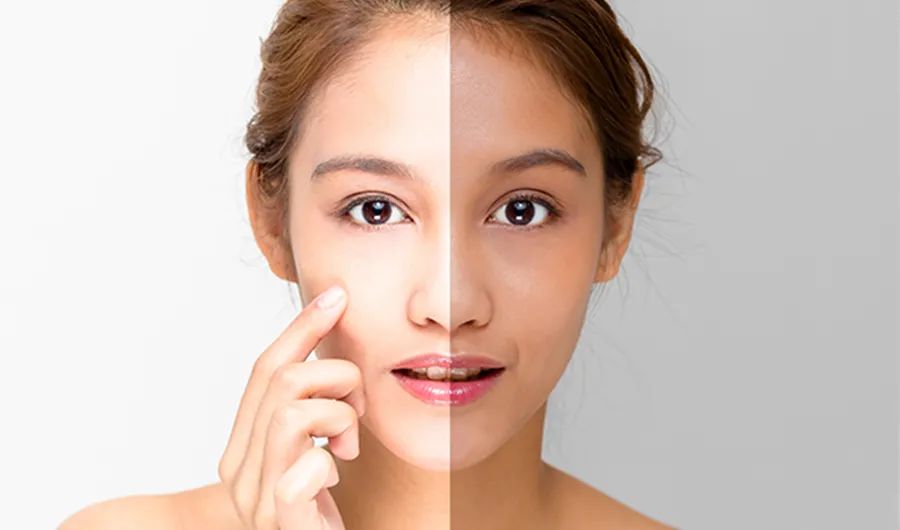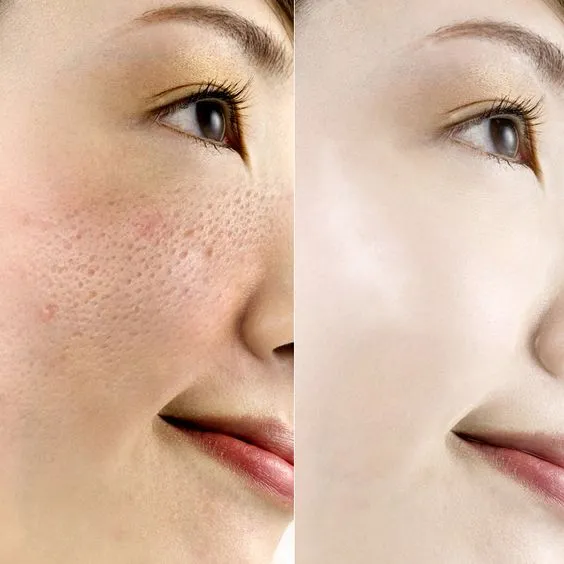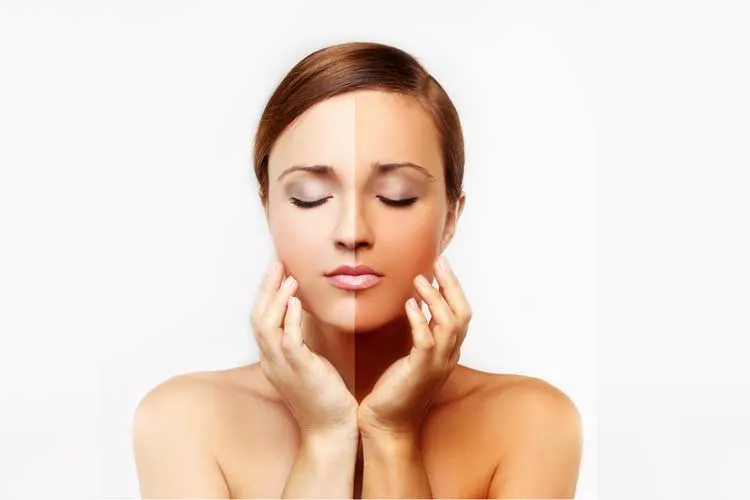What is Skin Whitening and Why Do People Seek It?
Skin whitening, also known as skin lightening or bleaching, is a cosmetic procedure aimed at reducing the melanin pigment in the skin to give it a lighter appearance. People seek skin whitening for a variety of reasons, often influenced by cultural beauty standards that prioritize lighter skin tones. In many societies, lighter skin is associated with youth, beauty, and higher social status. This can lead individuals to desire skin whitening to enhance their self-esteem and fit into these societal norms. The motivations vary, including addressing uneven skin tone, reducing the appearance of blemishes or dark spots, and achieving a more uniform complexion.
Understanding Hyperpigmentation Causes and Types
Hyperpigmentation, the primary target of skin whitening treatments, is the darkening of an area of skin caused by an increase in melanin. There are several types of hyperpigmentation, each with different causes. Understanding the specific type of hyperpigmentation is crucial for choosing the most effective treatment approach. The common types include post-inflammatory hyperpigmentation (PIH), melasma, and sunspots (solar lentigines). PIH often follows skin injuries, acne, or inflammation. Melasma is frequently linked to hormonal changes, such as those during pregnancy or from birth control pills. Sunspots are mainly caused by prolonged sun exposure.
Sun Exposure

Sun exposure is a major contributing factor to various forms of hyperpigmentation, including sunspots and the exacerbation of melasma. Ultraviolet (UV) radiation from the sun stimulates melanocytes, the cells that produce melanin, to increase melanin production. This is the body’s natural defense mechanism to protect the skin from sun damage. However, excessive sun exposure without proper protection can lead to uneven melanin production, resulting in dark spots and an uneven skin tone. Regular and consistent sun protection is crucial to prevent and manage sun-induced hyperpigmentation.
Hormonal Changes
Hormonal changes, particularly those related to pregnancy (melasma), hormonal birth control, and hormone replacement therapy, can trigger or worsen hyperpigmentation. These hormonal fluctuations can stimulate melanocytes to produce more melanin, leading to dark patches, typically on the face. Melasma, often referred to as the “mask of pregnancy,” is a common condition among pregnant women. Addressing hormonal imbalances through medical consultation and managing sun exposure are key strategies in controlling hormonally induced hyperpigmentation. The skin often becomes more sensitive during these periods, making sun protection even more critical.
Inflammation and Skin Trauma
Inflammation and skin trauma, such as acne, eczema, burns, or cuts, can lead to post-inflammatory hyperpigmentation (PIH). When the skin is injured or inflamed, the melanocytes become overactive, producing excess melanin in the affected area. This can result in dark spots or patches that remain even after the initial wound has healed. The severity of PIH depends on the depth and duration of the inflammation, as well as individual skin characteristics. Careful management of skin conditions to minimize inflammation and sun protection are crucial for preventing and minimizing PIH.
Effective Skin Whitening Methods

Several effective methods can help lighten the skin and reduce hyperpigmentation. It’s important to consult with a dermatologist to determine the best approach for your specific skin type and condition. The options include topical creams, chemical peels, laser treatments, and oral supplements. Each method has its own mechanisms, potential benefits, and risks. It’s essential to understand these aspects before starting any skin whitening treatment. The effectiveness of each method also depends on factors like the type and severity of the hyperpigmentation, as well as individual skin characteristics and commitment to a comprehensive skincare routine.
Topical Creams and Serums
Topical creams and serums containing specific ingredients are a common and accessible way to address hyperpigmentation. Key ingredients include hydroquinone, retinoids, vitamin C, kojic acid, azelaic acid, and niacinamide. Hydroquinone is a potent skin-lightening agent that inhibits melanin production. Retinoids, derived from vitamin A, promote cell turnover and reduce the appearance of dark spots. Vitamin C is an antioxidant that can brighten the skin and protect against sun damage. Kojic acid and azelaic acid also work to reduce melanin production. Niacinamide, a form of vitamin B3, can reduce hyperpigmentation and improve skin tone. It’s important to use these products as directed by a dermatologist and to start slowly to avoid irritation.
Chemical Peels
Chemical peels involve applying a chemical solution to the skin to exfoliate the outer layers, revealing brighter, more even-toned skin. The strength of the peel varies from superficial to deep, with deeper peels offering more dramatic results but also carrying a higher risk of side effects. Common types of chemical peels include alpha-hydroxy acids (AHAs), such as glycolic and lactic acid, beta-hydroxy acids (BHAs), such as salicylic acid, and trichloroacetic acid (TCA). AHAs and BHAs are used for milder hyperpigmentation and can be done regularly, while deeper peels are typically performed in a dermatologist’s office. After a chemical peel, it is essential to protect the skin from the sun to prevent further hyperpigmentation.
Laser Treatments

Laser treatments use focused light energy to target and break down melanin in the skin, effectively reducing the appearance of dark spots and uneven pigmentation. Different types of lasers are used depending on the type and depth of hyperpigmentation. Intense pulsed light (IPL) is a popular choice for sunspots and uneven skin tone. Other lasers, such as Q-switched lasers, are used for deeper pigmentation issues. Laser treatments require multiple sessions, and the results can vary depending on the individual and the type of laser used. Post-treatment care includes avoiding sun exposure and using prescribed skincare products to aid healing and prevent complications.
Oral Supplements
Oral supplements, such as glutathione and vitamin C, are sometimes used to promote skin lightening from the inside out. Glutathione is a powerful antioxidant that can inhibit melanin production. Vitamin C, in addition to its topical benefits, can also support skin health when taken orally. While some studies suggest that oral supplements can be effective, the results can vary, and the efficacy is still under investigation. It is crucial to consult with a healthcare professional before taking any supplements to ensure safety and to avoid potential interactions with other medications or health conditions.
The Role of Exfoliation and Cleansing
Exfoliation and cleansing are essential components of any effective skin whitening routine. Exfoliation removes dead skin cells, promoting cell turnover and allowing skin-lightening agents to penetrate more effectively. It also helps to reveal a brighter, smoother complexion. Cleansing removes dirt, oil, and impurities from the skin, preparing it for other treatments. Both physical exfoliants (scrubs) and chemical exfoliants (AHAs, BHAs) can be used, but it’s important to choose a method suitable for your skin type and to avoid over-exfoliation, which can lead to irritation. A gentle, effective cleansing routine forms the foundation of healthy and radiant skin.
Choosing the Right Products for Your Skin Type

Selecting the right products for your skin type is crucial for achieving the best results and minimizing potential side effects. Different skin types have different needs and sensitivities. Before starting any skin whitening treatment, it’s essential to identify your skin type (e.g., dry, oily, combination, sensitive). Products that work well for one person may not be suitable for another. A dermatologist can help you determine your skin type and recommend appropriate products. Always perform a patch test before applying any new product to a larger area of the skin to check for adverse reactions. Customizing your routine to your skin type ensures optimal results and reduces the risk of irritation or other complications.
Sensitive Skin Considerations
Sensitive skin is prone to irritation, redness, and allergic reactions. When choosing skin whitening products, those with sensitive skin should opt for gentle formulations with fewer potential irritants. Look for products that are fragrance-free, alcohol-free, and hypoallergenic. Start with low concentrations of active ingredients and gradually increase if tolerated. It’s advisable to avoid harsh exfoliants and strong chemical peels. Always do a patch test before using a new product. Consulting a dermatologist for product recommendations and guidance is highly recommended for people with sensitive skin, to minimize the risk of adverse reactions.
Oily and Acne-Prone Skin
Oily and acne-prone skin requires products that control oil production and prevent breakouts. For skin whitening, choose lightweight, non-comedogenic (won’t clog pores) products. Ingredients like salicylic acid (BHA) can help exfoliate and unclog pores, reducing acne. Azelaic acid is also effective for treating acne and reducing hyperpigmentation. Avoid heavy creams or oily formulations that can exacerbate breakouts. A consistent skincare routine, including gentle cleansing, exfoliation, and the application of appropriate skin-lightening agents, is crucial for managing both hyperpigmentation and acne. Consider consulting a dermatologist for personalized recommendations.
Dry Skin and Hydration

Dry skin needs hydration and moisture to maintain its health and appearance. When choosing skin whitening products, select hydrating formulas with ingredients that lock in moisture. Look for products that contain humectants (e.g., hyaluronic acid, glycerin) and emollients (e.g., ceramides, shea butter). Avoid harsh exfoliants that can further dry out the skin. A gentle cleansing routine and regular use of moisturizers are essential. Drinking enough water and using a humidifier can also help keep the skin hydrated. Always ensure the skin is well-hydrated before using skin-lightening treatments, as dry skin can become more sensitive to active ingredients.
Lifestyle and Diet for Optimal Results
Lifestyle and diet play a significant role in skin health and can enhance the effectiveness of skin whitening treatments. A healthy lifestyle that includes a balanced diet, adequate hydration, and sun protection promotes overall skin health and improves the results of treatments. Avoidance of smoking and excessive alcohol consumption is also beneficial. In addition, certain dietary habits can influence skin health. Antioxidant-rich foods, in particular, can help protect the skin from damage and support a healthy complexion. A holistic approach, that includes lifestyle factors, maximizes the positive outcomes of any skin-whitening strategy.
Healthy Diet for Skin
A diet rich in fruits, vegetables, and antioxidants provides essential nutrients that support skin health and can enhance the effectiveness of skin-whitening treatments. Antioxidants protect the skin from free radical damage, which can lead to hyperpigmentation and premature aging. Foods rich in vitamin C (citrus fruits, berries), vitamin E (nuts, seeds), and other antioxidants (green leafy vegetables) are particularly beneficial. Including foods with anti-inflammatory properties, such as omega-3 fatty acids (found in fish and flaxseeds), can also contribute to a healthy complexion. A balanced diet that provides these nutrients helps to support the skin’s natural functions and promotes an even skin tone.
Hydration and Water Intake

Adequate hydration is crucial for skin health and overall well-being. Water helps to flush out toxins, keeps the skin cells plump and hydrated, and improves the skin’s elasticity. Dehydration can make the skin appear dull, dry, and accentuate the appearance of dark spots. Drinking enough water throughout the day supports the skin’s natural functions and enhances the effectiveness of skin-whitening treatments. Aim to drink at least eight glasses of water a day, and increase your intake in hot weather or after exercise. Hydration is a cornerstone of healthy, radiant skin.
Sun Protection and Skincare Routine
Sun protection is the single most important aspect of a skin-whitening routine. UV radiation from the sun stimulates melanin production, which can negate the efforts of skin-lightening treatments and worsen hyperpigmentation. Consistent sun protection is vital to prevent new dark spots from forming and to allow existing ones to fade. In addition to sunscreen, a comprehensive skincare routine should be followed. This routine includes cleansing, exfoliation, and the application of skin-lightening products to support skin health and promote a brighter complexion. Developing consistent habits and following a dedicated skincare routine delivers optimal results.
Daily Sunscreen Application
Daily sunscreen application is the foundation of effective sun protection. Choose a broad-spectrum sunscreen with an SPF of 30 or higher that protects against both UVA and UVB rays. Apply sunscreen generously to all exposed skin areas at least 15–30 minutes before sun exposure and reapply every two hours, or more often if swimming or sweating. Even on cloudy days, UV rays can penetrate the clouds and damage the skin. Sunscreen helps prevent new dark spots from forming and protects the skin from further damage, allowing skin-lightening treatments to work effectively. This essential habit is fundamental for achieving and maintaining a brighter, more even skin tone.
Creating a Consistent Skincare Routine
Creating a consistent skincare routine is critical for achieving and maintaining skin-whitening results. Consistency ensures that the skin-lightening products and sun protection measures are applied regularly, allowing them to work effectively. A typical routine includes cleansing to remove impurities, applying skin-lightening products, and moisturizing to hydrate the skin. In the morning, sunscreen application is essential. In the evening, a gentle exfoliation can be added, followed by application of skin-lightening treatments. Consistency and patience are key. It takes time for the skin to respond to treatments, so it’s important to stick to the routine. Making skincare a daily habit and sticking to it will lead to noticeable improvements.
Potential Risks and Side Effects of Skin Whitening
Skin whitening treatments, while often desired, carry potential risks and side effects. It’s important to be aware of these risks and to discuss them with a dermatologist before starting any treatment. Potential complications include skin irritation, sensitivity, and, in some cases, more serious issues. Understanding the risks and taking necessary precautions can help minimize the chances of adverse effects. This includes following the instructions of a healthcare professional, performing patch tests before using any new products, and being patient with the process.
Overuse of Products
Overuse of skin-whitening products can lead to several adverse effects. Using too many products or applying them too frequently can disrupt the skin’s natural barrier, leading to irritation, redness, and dryness. Overuse of harsh ingredients like hydroquinone or retinoids can cause skin thinning and increased sensitivity to the sun. Following the instructions provided by a dermatologist, and using products as directed is extremely important. It’s important to gradually introduce new products and to monitor the skin’s response carefully. If you experience any adverse reactions, discontinue use and consult a dermatologist.
Skin Irritation and Sensitivity
Skin irritation and increased sensitivity are common side effects of skin-whitening treatments. This is particularly true for individuals with sensitive skin or when using strong ingredients or improper application. Symptoms can include redness, itching, burning, and peeling. Over-exfoliation or using multiple active ingredients simultaneously can exacerbate these issues. Performing a patch test before applying a new product to a larger area of the skin can help identify potential reactions. It is necessary to stop using a product if irritation occurs. A dermatologist can advise on how to minimize these effects and choose appropriate skincare products that are gentle and effective.
Long-Term Considerations and Maintenance
Long-term considerations and maintenance are crucial for preserving the results of skin-whitening treatments and maintaining healthy skin. Skin-whitening is not a one-time fix; it requires ongoing care and attention to prevent the return of hyperpigmentation. This includes regular sun protection, a consistent skincare routine, and periodic maintenance treatments. Understanding the importance of these steps will help individuals achieve long-lasting results and maintain a radiant complexion. Continuous care is the key to ensuring that the skin remains healthy and the skin-lightening effects are sustained over time.
Maintenance after Treatment
Maintenance after skin-whitening treatment is essential to sustain the results achieved. This typically involves continuing a consistent skincare routine, including regular sun protection, gentle cleansing, and the use of maintenance products. These maintenance products often contain lower concentrations of active ingredients than the initial treatments. Regular follow-up appointments with a dermatologist are important for monitoring the skin’s condition and adjusting the routine as needed. Lifestyle factors such as a healthy diet and avoiding excessive sun exposure also contribute to maintaining a brighter complexion. Consistent maintenance ensures that the benefits of the skin-whitening treatments persist over the long term.
Realistic Expectations and Patience
Realistic expectations and patience are key aspects of any skin-whitening journey. Skin-whitening treatments take time to show results, and it’s important to be patient and consistent with the routine. The speed and extent of improvement vary based on the type of hyperpigmentation, the treatment used, and individual skin characteristics. Setting realistic goals, knowing that the skin-whitening process may take several weeks or months to show noticeable changes. Understanding this aspect helps to avoid disappointment and to remain committed to the treatment plan. Patience is essential to maintaining a positive outlook and staying focused on achieving a brighter, healthier complexion over time.
